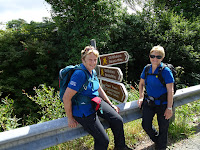The Ride to
Dublin
Kathleen
takes us to Bantry, a small village further up the Coast where we will catch
the Cork bus. The day is windy, cold and drizzling rain. The bus starts the
drive at this village so leaves on time and a full passenger load. The trip
only takes two hours and we then have to wait a short time at the bus depot
before we meet the express bus to Dublin, back where we started 4 weeks ago.
Our last few days in Dublin will be spent with Eileen and Tom and Syd, a very friendly
house dog. Comfortable after many nights in Hotels and B & Bs.
The sights
of Dublin and Powers Court Estate
The
day is mild and light rain showers but I do not care as we are not walking
today. We are going to be tourists today and the first stop is Dunlaoghaire the Dublin Port. Dark clouds are forming
so we do not stay long. A lovely spot to wander along the pier and beach front.
We
then head towards Killarney Hill, a decent climb of 153 metres and great views
over Dublin, Bray Head, Wicklow Mountains and the Irish Sea. The park is
crossed by various walking tracks, and with its spectacular views in all
directions, is a popular destination for walkers and hikers from the
surrounding areas.The day is starting to warm up so we drive down to the popular coastal
village of Greystones in County Wicklow. We settle for a coffee at the “Happy
Pear”, a small coffee shop which originally started as a fruit shop. This is a
very trendy area.
Next
stop is at Powers Court Estate located in Enniskerry. It is a large country
estate noted for its house and landscaped gardens, today occupying 19 hectares
(47 acres). The house, originally a 13th-century castle, was extensively
altered during the 18th century but a fire in 1974 left the house lying as a
shell until it was renovated in 1996. The estate shows a sublime blend of
formal and walled gardens, sweeping terraces, statues and ornamental lakes,
secret hollows and rambling walks, pet cemeteries and Japanese gardens, the
Pepperpot Tower and Dolphin Pond.
The day has turned quite warm; we head towards the
magnificent garden full of roses every colour of the rainbow. So many different
colours, shapes and sizes and varieties. All we can do is sit and marvel. The
landscaping and design of the terraced Italian Gardens linking the house to the
lake with the life sized Winged Horses watching over the lake. Why do our gardens
look so bland?
One of the most interesting parts of Powerscourt Gardens
is the pet’s cemetery which is the resting place of the much-loved pets of the
estate families. It’s situated in a quiet part of the gardens where the
striking colours of Azaleas, Rhododendrons and Roses bloom. The cemetery is
believed to be the largest pets’ cemetery in any private Irish garden.
The Powerscourt horses – Boncho, Giddy and Glencree could
be seen grazing along the road in the field below Triton Lake. Small ducklings playing
near the water’s edge under the watchful eye of the mother duck. The Dolphin
Pond with its central fountain of dolphins spouting water is another not to be
missed attraction.
After walking through Tower Valley our next stop is the
Japanese Garden. We reach Lord Londonderry’s stone seat, perched high above the
Japanese Garden laid out over 100 years ago. Stone lanterns guide us through
the winding paths of the garden, bringing us to its innermost circle where we
find a Pagoda and a trickling stream under Japanese stone bridges. The upper
circle provides stunning views of the Japanese Garden and the Sugar Loaf
Mountain in the distance.
Hunger pains have started so a visit to the Avoca Terrace Café offering an
amazing setting for us all to relax and enjoy a cup of coffee and cake. The
café boasts tall windows and French doors leading out onto an expansive garden
terrace with a simply breath-talking panorama of the gardens against the
backdrop of Sugarloaf Mountain. The food at the Terrace Café is homemade and of
excellent quality. A lovely way to end a lovely day and a lovely stay in
Ireland. Powers Court Estate is the home and workplace of my husband’s family
in the 1850’s before they migrated to Australia.
As the day closes we make our way back to Dublin in the afternoon peak hour
traffic, another lovely home cooked meal and an early night. Tomorrow we must
repack as we leave Ireland.
We spend the day catching up with diaries and photos, packed and repacked;
nothing goes back in the same spot so some must be relegated to the bin. I am
sure the weight of my case will be borderline so will wear my boots on the
plane, easy to get off when we reach Australian customs. An early meal and Tom
drives us across to the Dublin International Airport. We are quickly checked in
and through the gates and now we can spend some of the euros we have not spent.
Time to sit, reflect and wait for our Emirates flight to Dubai.
Where has the last 5 weeks gone, in a few days we will be back at work and
the same old routine. Time to think about where we will next walk - the bug has
attached itself firmly.
We have walked 547klms through Ireland for the boys, we have returned to
Ireland for Mum, we have made friendships to
last a lifetime and we have raised $11300 for Cancer Queensland Research. Not a
bad effort if I may say so.
We have walked
Ireland for the craic.





















































